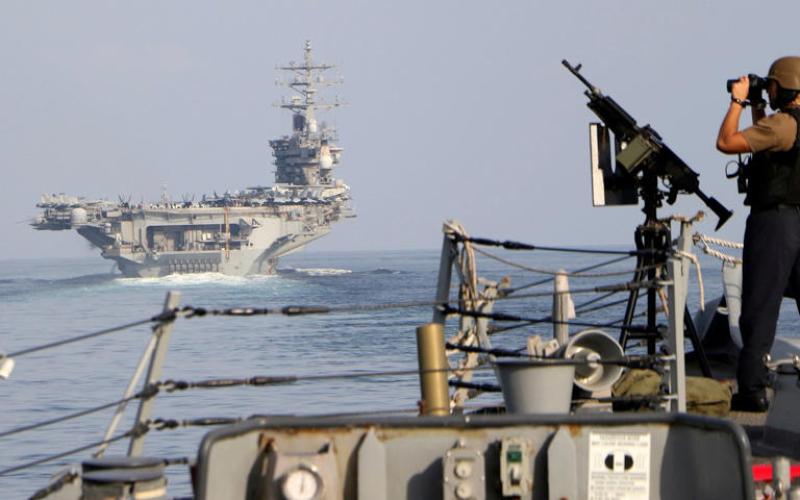Red Sea War: Houthi drone boat detonation opens a new chapter
By: Tom Sharpe



Y esterday, the ongoing disruption of shipping in the Red Sea took an interesting turn. The Uncrewed Surface Vessel (USV), a threat well known to anyone who has operated in the Gulf in the last few years – and very well known to the Russian Black Sea Fleet, some of whom have taken up residency on the bottom as a result – made its appearance in the southern Red Sea .
So far, details are scant. Vice Admiral Cooper, the US Fifth Fleet commander based in Bahrain, said:
“This was a one-way attack, unmanned surface vessel that had launched from Houthi-controlled territory, had transited out to international shipping lanes, clearly with the intent to do harm. Fortunately, it detonated. It’s unclear who the target vessel was…”
It’s a significant development for Operation Prosperity Guardian (OPG), the international naval effort whose aim seems to be something like “providing sufficient reassurance to shipping companies to restore the freedom of navigation in the Red Sea”.
First, it’s clear that the Houthis show no sign of slowing down, despite a joint statement from the governments of the United States, Australia, Bahrain, Belgium, Canada, Denmark, Germany, Italy, Japan, Netherlands, New Zealand, South Korea, Singapore and the United Kingdom on 3 December that this must not continue. The entirely defensive nature of OPG coupled with ‘stern warnings’ isn’t deterring the Houthis.
Second, the USV explosion will not help reassure the major shipping companies such as Maersk, MSC, Hapag-Lloyd and Evergreen who have elected to route around the Cape of Good Hope rather than run the Houthi gauntlet through the Bab-el-Mandeb chokepoint. For the big shippers, the strait truly is living up to its name: the Gate of Grief.
It is important to note that despite the big companies currently not making the transit, many ships still are. Whilst container shipping numbers are down 20 per cent, overall numbers are down by only a few percent. This reflects the complexity of the shipping business and the sheer number of vessels of all sizes and types who are happy to take the risk, do not believe themselves to be under threat and in some (probably illegal) cases, may even be assured of protection. However, whilst ‘the big ones’ are wobbling, short-term rates for container shipping have increased by 173% from mid-December. This and other costly trends are only going one way and will do so until the situation settles. The arrival of USVs on the scene will not help.
Arleigh Burke class destroyer USS Laboon, one of the warships now operating in the Red Sea, fires a missile on a previous occasion - Reuters © Provided by The Telegraph
Third, the USV provides a tactical dilemma for the warships of OPG who are tasked to defend against the differing threats there. I postulated a while ago that these ships will be operating in air defense boxes up the eastern side of the Southern Red Sea in which they have responsibility for providing cover from missiles and drones, and that occasionally, they would be detached to provide escort cover for specific ships. This methodology was confirmed yesterday by Admiral Cooper.
The USV threat changes a couple of things. First, it puts more emphasis on the requirement for persistent fast jet and helicopter cover – these are the best ways to deal with USVs. Aviation fuel bills for OPG just went up. Second, the ships in the boxes nearest where this threat is based now have to deal with both air and surface threats. This can be done concurrently but with as little as thirty seconds warning time for the very fastest missile threat, it is not easy.
On its own, a single USV isn’t a problem. However, send a swarm of them and it is a different matter. And swarm tactics are Navy Warfare 101 for the country that is both training and supplying the Houthis. Added to this is the vast amount of small boat traffic zipping around there anyway, fishing, smuggling and who knows what else. Under normal conditions you have to be on your guard because these things are fast, low in the water and don’t paint well on radar, but it used to be reasonably safe to assume that they’re not packed with explosives and heading for you. Now, the warships will have to assume that they are.
Finally, and perhaps most important, is the nature of the damage a USV would cause if it got through compared to the Houthis’ missiles. The latest missile and drone figures (courtesy of @Schizointel ) show that in the last months, the Houthis have fired 14 anti-ship ballistic missiles, one anti-ship cruise missile, six land attack cruise missiles and 72 drones. Of these, the ships of OPG have defeated six ASBMs, six LACMs and 60 drones. This impressive strike rate of 77 per cent shows two things. First, the ships there are doing an outstanding job in a complex multi-threat environment and second, there is no such thing as a ‘probability-of-kill’ of 100 per cent. Hollywood leads you to believe there might be, real warfare does not.
So far, the missiles that have snuck through and struck targets have not been catastrophic. The fire on the chemical tanker MV Strinda on 12 December was probably the worst but the crew did an excellent job to bring it under control, no one died and there was no spillage. However, if a USV hits a vessel it will likely hole it at the waterline. It will be carrying a large explosive charge and even a double-hulled vessel is likely to be pierced. Best case, whatever is behind that hole spills into the Red Sea. Worst case, the ship sinks and people die. If the ship is an oil tanker or gas carrier, you’re looking at a major explosion.
Clearly, a 77 per cent reassurance isn’t enough for the major carriers just yet. So we need to ask: what is enough, how many ships and aircraft does that take, and how long can it be sustained? While OPG remains entirely defensive in the face of this steady stream of attacks, it’s hard to say that a sustainably reassuring solution is achievable, no matter how much excellent work goes into improving civil-military liaison at sea.
So the Houthis will continue to excel at keeping their activity sub-threshold, sapping resources and sowing discord. It’s a very effective operation.
Meanwhile, quite apart from destructive warfare from the Houthis, actual pirates are making a comeback. The Houthi helicopter hijack of Galaxy Leader on 22 November stole the headlines but MV Ruen has been at anchor off Somaliland since 14 December. Yesterday another vessel was taken 460 nautical miles to the east in the middle of the Indian Ocean. The old game of seizing ships to make money, as opposed to making a political point, has begun again. That this is emerging as an issue for the first time since 2017 isn’t a coincidence.
HMS Diamond, the British air defence destroyer on task in the Red Sea. Diamond has shot down a Houthi missile using her Sea Viper interceptors - AS1 Amber Mayall/Royal Air Force © Provided by The Telegraph
It will also probably not be that long before a mine is seen (either real or imagined) in the Bab-el-Mandeb. The main strait is several hundred metres deep, so not a good place for moored or seabed mines, but drifting unmoored floating mines can be released anywhere. They’re illegal under the Hague Convention, and ironically enough Iran did sign up to this back in 1907, but today’s mullahs haven’t felt bound by this in previous Gulf mining campaigns . The one good thing about drifting mines is that they’re much easier to see and dispose of (by simply shooting them so that they sink or blow up) than other kinds of mine. An even better method is destroying the craft that lays them. Even so, in big enough numbers mines could be a real problem.
So OPG continues to take shape in the face of a diversifying threat, masses of ongoing liaison work across the vast shipping sector, countries joining, countries joining with caveats/agendas and countries who have vested interests there but are not bothering. We must give OPG time – the threat, merchant vessel complexity and political uncertainty demand it. Ultimately though, a purely defensive naval operation is unlikely to deliver sustainable reassurance.
An operation which was allowed to make offensive strikes into Houthi territory, I believe, could deliver such reassurance: but thus far the White House has declined to cross that line and those allies which could act have decided to follow the US. In my view, the emergence of USVs won’t change that – but it will if one gets through.
Hope is not a strategy.
Tom Sharpe is a former Royal Navy officer and surface combatant warship captain, with experience in the Gulf and Red Sea
No personal insults
No death wishes of any individual
All of NT's rules apply
PS
Calling members "trolls" or ""dishonest" will result in your comment being deleted.










First, it’s clear that the Houthis show no sign of slowing down, despite a joint statement from the governments of the United States, Australia, Bahrain, Belgium, Canada, Denmark, Germany, Italy, Japan, Netherlands, New Zealand, South Korea, Singapore and the United Kingdom on 3 December that this must not continue. The entirely defensive nature of OPG coupled with ‘stern warnings’ isn’t deterring the Houthis.
Nope, "stern warnings" aren't going to do it.
The USV threat changes a couple of things. First, it puts more emphasis on the requirement for persistent fast jet and helicopter cover – these are the best ways to deal with USVs. Aviation fuel bills for OPG just went up. Second, the ships in the boxes nearest where this threat is based now have to deal with both air and surface threats. This can be done concurrently but with as little as thirty seconds warning time for the very fastest missile threat, it is not easy.
Nope, it isn't going to be easy at all.
Ultimately though, a purely defensive naval operation is unlikely to deliver sustainable reassurance.
Amen.
An operation which was allowed to make offensive strikes into Houthi territory, I believe, could deliver such reassurance: but thus far the White House has declined to cross that line and those allies which could act have decided to follow the US. In my view, the emergence of USVs won’t change that – but it will if one gets through.
Hope is not a strategy.
It is for the supporters of the Biden policy.
Brandon has given the Iranians a great testing ground for the drones (both ariel and sea); and land to ship missiles.
Wonder how long before one of our vessels suffers casualties since they are unable to take out launch sites and those directly responsible for launching/firing the drones/missiles.
It is very similar to the LBJ strategy during Vietnam.